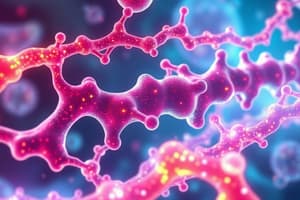Podcast
Questions and Answers
What does the acronym OIL RIG represent in redox reactions?
What does the acronym OIL RIG represent in redox reactions?
- Oxidation Is Light, Reduction Is Gas
- Oxygen Is Lost, Reaction Is Gained
- Oxidation Is Loss, Reduction Is Gain (correct)
- Oxidation Involves Losing, Reduction Involves Gaining
Which molecule is primarily produced during glycolysis?
Which molecule is primarily produced during glycolysis?
- Acetyl-CoA
- Lactate
- Glucose
- Pyruvate (correct)
Which stage of cellular respiration occurs within the mitochondria?
Which stage of cellular respiration occurs within the mitochondria?
- Photosynthesis
- Glycolysis
- The Citric Acid Cycle (correct)
- Fermentation
What is the primary function of ATP synthase during chemiosmosis?
What is the primary function of ATP synthase during chemiosmosis?
In what cellular location does translation occur?
In what cellular location does translation occur?
Flashcards
Enzymatic Reaction
Enzymatic Reaction
A chemical reaction catalyzed by an enzyme. Enzymes speed up reactions by providing an active site where substrates bind and react to form products.
OIL RIG
OIL RIG
OIL RIG is a mnemonic for remembering the rules of redox reactions. OIL stands for Oxidation Is Loss (of electrons), and RIG stands for Reduction Is Gain (of electrons).
Cellular Respiration Equation
Cellular Respiration Equation
The basic equation for cellular respiration is: C6H12O6 + 6O2 → 6CO2 + 6H2O + ATP. Glucose (C6H12O6) and oxygen (O2) are the reactants, and carbon dioxide (CO2), water (H2O), and ATP are the products.
Oxidative Phosphorylation
Oxidative Phosphorylation
Signup and view all the flashcards
Translation
Translation
Signup and view all the flashcards
Study Notes
Enzymatic Reactions
- Enzymes are biological catalysts that speed up reactions.
- The active site is the region of the enzyme that binds to the substrate.
- The substrate is the molecule that the enzyme acts upon.
- Reactants are the molecules present before the reaction.
- Products are the molecules formed during the reaction.
- An allosteric location is a site on the enzyme other than the active site that can affect enzyme activity.
Redox Reactions
- OIL RIG: Oxidation Is Loss, Reduction Is Gain.
- Electrons are gained or lost in redox reactions.
Cellular Respiration
- Basic equation: C₆H₁₂O₆ + 6O₂ → 6CO₂ + 6H₂O + ATP
- Reactants: Glucose (C₆H₁₂O₆) and Oxygen (O₂)
- Products: Carbon dioxide (CO₂), Water (H₂O), and ATP
- Source of reactants: Glucose from food; oxygen from breathing.
- Fate of products: Carbon dioxide is exhaled; water is used in bodily functions; ATP is used for cellular work.
Cellular Respiration Stages
| Stage | Main Purpose | Aerobic/Anaerobic | Product(s)/Byproduct(s) | Location |
|---|---|---|---|---|
| Glycolysis | Break down glucose into pyruvate | Anaerobic | 2 ATP, 2 NADH, 2 Pyruvate | Cytoplasm |
| Pyruvate Breakdown | Convert pyruvate to Acetyl CoA | Aerobic | 2 NADH, 2 CO₂ per glucose | Mitochondrial matrix |
| Citric Acid Cycle | Complete oxidation of acetyl CoA | Aerobic | 6 NADH, 2 FADH₂, 2 ATP, 4 CO₂ per glucose | Mitochondrial matrix |
| Oxidative Phosphorylation | Generate ATP via electron transport chain | Aerobic | 32-34 ATP per glucose | Inner mitochondrial membrane |
ATP Production
- Oxidative phosphorylation generates the most ATP during cellular respiration.
Electron Carriers
- NADH and FADH₂ are electron carriers that feed into the electron transport chain.
ATP Synthase
- ATP synthase is the enzyme responsible for ATP synthesis during chemiosmosis.
Fermentation
- The main purpose of fermentation is to regenerate NAD+ for glycolysis in the absence of oxygen.
- It occurs when oxygen is not available.
Translation
- The general purpose of translation is to synthesize proteins.
- mRNA gets translated and a polypeptide (protein) is produced.
- Translation occurs in the ribosomes in the cytoplasm of the cell.
Genetic Code
- Given a DNA or mRNA sequence, the genetic code can be used to determine the corresponding polypeptide sequence.
Studying That Suits You
Use AI to generate personalized quizzes and flashcards to suit your learning preferences.




